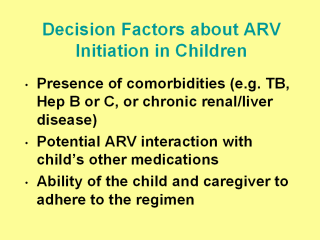| front |1 |2 |3 |4 |5 |6 |7 |8 |9 |10 |11 |12 |13 |14 |15 |16 |17 |18 |19 |20 |21 |22 |23 |24 |25 |26 |27 |28 |29 |review |
 |
Presence of co-morbidity that could affect drug
choice, such as tuberculosis, hepatitis B or C infection, or chronic renal
or liver disease (for example, coadministration of rifampin can
significantly reduce drug levels of nevirapine and most protease inhibitors;
viral hepatitis can predispose to hepatic toxicity of nucleoside and
non-nucleoside antiretroviral drugs; and, depending upon the route of
metabolism/excretion for individual drugs, dose modification may be required
for individuals with significant renal/liver disease); Potential antiretroviral drug interactions with other medications required by the child; and The ability of the caregiver and child to adhere to the regimen. |